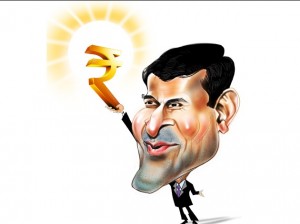William Pesek writes: Raghuram Rajan’s recent surprise rate cut in India was what central bankers call an “insurance move.” In a highly uncertain and deflationary world, the Reserve Bank of India governor decided he’d rather risk higher inflation in hopes of boosting growth. More quietly, Rajan is hoarding dollars.
On Friday, the day before Barack Obama flew to New Delhi, the RBI announced that India’s foreign-exchange reserves had risen to a record $322 billion. While the news couldn’t compete with the Modi-Obama hug at the airport, a nuclear deal and talk of cooperation on climate change, that swelling stash greatly increases the odds that Modi’s reform program will succeed.
By slashing the benchmark rate to 7.75 percent from 8 percent, the RBI governor made clear the central bank was ready to guard India’s economy against a fast-mounting number of risks around globe. Equally important was the “vote of confidence” the decision signaled about Modi’s government.
Now Rajan’s stockpiling of currencies should help catalyze change in New Delhi. As recently as September 2013, when Rajan started at the RBI, India was spiraling toward crisis. An economy once celebrated as one of the superpowers of the future — Brazil, Russia, India and China, or the BRICs — was being grouped among the world’s most “fragile” nations. Hedge funds bet India would be the first of the BRICs to be downgraded to junk.
Rajan moved fast to halt a run on the rupee, shore up the banking system and cap inflation. Rajan has stockpiled about $59 billion of reserves since taking charge at the RBI, or an average of $4 billion per month. While India’s reserves are still a fraction of China’s $3.8 trillion, they’re substantial enough now to “create a stronger firewall against external account shocks and build greater international confidence,” says Rajiv Biswas of IHS Global Insight.
India represents something of an outlier in the region. While Asian peers devalue to boost exports, Rajan has clearly decided that a stable, strong rupee is the key to cementing trust in India’s economy, which still suffers from a sizable current-account deficit and relies on short-term capital flows. A firm currency should attract overseas capital to support equities, upgrade infrastructure and pay down government debt.
In July, the prime minister’s first budget avoided “big bang” reforms like allowing foreigners to hold majority stakes in key sectors like insurance and defense. His government sidetracked a World Trade Organization deal to cut tariffs. And while he harnessed the plunge in oil prices to trim subsidies, Modi has been slow to dismantle budget-busting support programs.
Modi enters the budget process with a rare economic tailwind. By stabilizing the financial system and shoring ups its defenses, Rajan has given Modi considerably more latitude not only to restructure the economy, but to take risks like selling state assets and welcoming more foreign involvement in the economy. Once India reforms and moves beyond the boom-bust cycles of the past, it should be able to turn around and use its reserves to invest in education and healthcare as well as roads, bridges, ports and the power grid.
All Rajan has done, though, is prepare the ground. The onus still lies on Modi to push forward the politically difficult reforms he’s avoided thus far. He’s now got 322 billion good reasons to do so.

